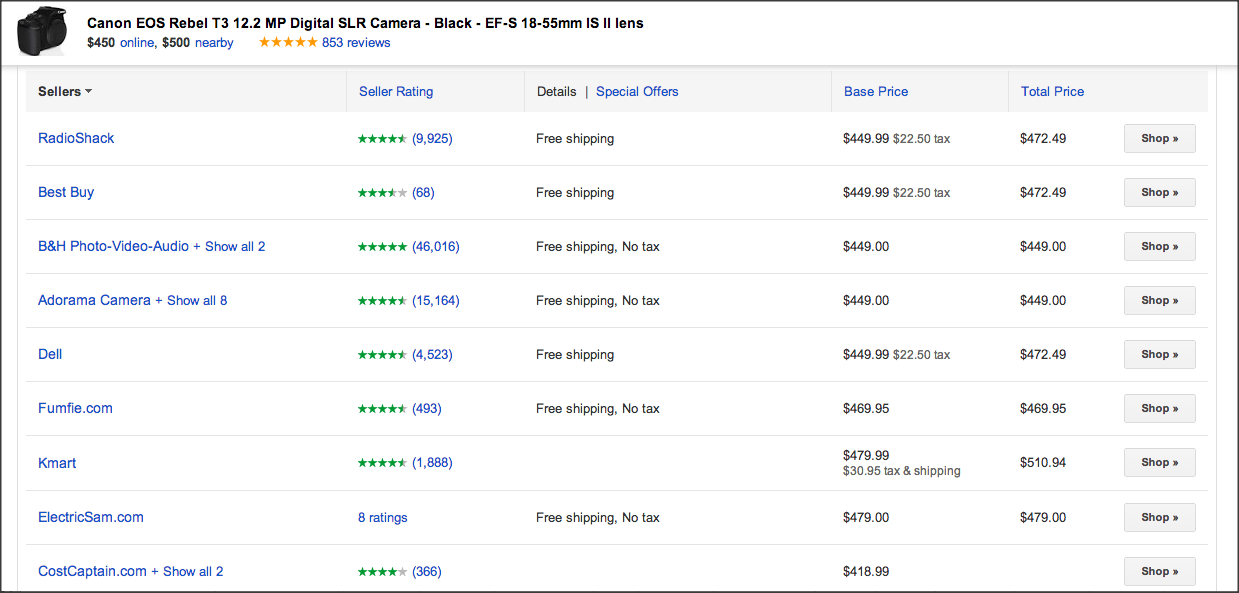10 Best Price Comparison Shopping Engines Websites Compare Prices Online
Post on: 27 Январь, 2016 No Comment

Comparison shopping engines (CSE’s) give ecommerce merchants the opportunity to attract new customers, increase sales, and go head-to-head against the competition.
This is an important guide that will explain what comparison shopping engines are, tell you the 10 best, and show you how to get your products listed.
What are Comparison Shopping Engines?
Comparison shopping engines collect product information, including pricing, from participating retailers and then display that collective information on a single results page in response to a shopper’s search query. In this way, shoppers can compare each retailer’s price, shipping options, and service on a single page and choose the merchant that offers the best overall value.
Example: Lets say I want to buy a Rubik’s Cube and want to see what my options are. I go to Google Shopping (one of the most popular CSE’s around) and do a search. Here’s what comes up:
For ecommerce merchants, comparison shopping engines are an opportunity to put your products in front of very interested buyers. These are not people perusing a virtual storefront like a window shopper at the mall, rather CSE users typically have already made the decision to buy and are simply looking for the best deal.
10 Popular Comparison Shopping Engines
1. Google Shopping
Google Shopping is probably the largest and best know comparison shopping engine. Products submitted to Google Shopping will also be displayed on standard Google search results and are integrated with Google’s pay-per-click platform, Adwords.
2. Nextag
Nextag has been in operation since 1999 and has as many as 30 million visitors each month. Nextag is consistently a top performer for traffic and conversions on CPC Strategy’s quarterly review of leading CSE’s. You can list products, event tickets, real estate, and even travel bookings.
3. PriceGrabber
In addition to presenting products on its site, PriceGrabber has a market research tool, Market Report, that allows retailers to track consumer purchase and product pricing trends. When you list your products on PriceGrabber, you’ll also be listed on Yahoo Shopping which is a nice added bonus.
4. Shopping.com
Shopping.com is part of eBay’s family of companies and is another great channel for merchants to put their products in front of perspective buyers. Shopping.com also partners with The Find, another CSE on this list.
5. Shopzilla
With about 40 million month visitors and a pedigree dating back to 1996, Shopzilla is one of the best choices for ecommerce merchants looking for some extra sales. This comparison shopping engine has an impressive 100+ million products listed.
6. Become
Become is another leader in the CSE space, allowing thrifty shoppers to compare prices, read or write product reviews, and simply search for the best possible online shopping deals.
7. Bing Shopping (Free)
Bing Shopping offers free product listings that appear directly on Bing search results pages. Bing Shopping has earned a lot of consumer praise for doing an excellent job of providing consumer friendly results. The service does not accept new merchant feeds during high-traffic shopping seasons, so get started early with Bing in 2013.
8. Pronto
With about 70 million product listings sorted into various retail verticals and millions of visitors monthly, Pronto certainly merits consideration for any retailer’s 2013 CSE campaigns.
9. The Find (Free)
In addition to showing product and price comparisons, The Find can help shoppers discover new products with personalized results.
10. Amazon Product Ads
Amazon isn’t technically a comparison shopping engine, but they work in a similar fashion. When you register for Product Ads you can upload your products manually or via FTP. Amazon will then create ads for your products using the information provided in your product file. When you set your budget, your ads will go live and you’ll pay-per-click.
The Cost of Comparison Shopping Engines
Although some of the CSE’s are free, most are going to charge you per click-through or per action. With pay-per-click, sellers pay a set fee or bid each time that a potential customer clicks on that merchant’s link. Here’s an example using Amazon:
In a pay-per-action model, retailers will pay a percentage of the value of a sale made as a result of being listed on the CSE. No one pricing model is best, so choose which works best for you.
How to get Products Listed in Comparison Shopping Engines
Shopify merchants have several apps available that make submitting product feeds to CSE’s easier and in some cases, automatic. For example, RetailTower is a free Shopify app that can help prepare feeds for many of the top CSE’s listed here. Regardless of how a feed is created, smart merchants will work to optimize descriptions and prices get the most sales possible.














